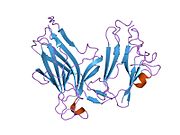Ephrin type-B receptor 4 is a protein that in humans is encoded by the EPHB4 gene.
Ephrin receptors and their ligands, the ephrins, mediate numerous developmental processes, particularly in the nervous system. Based on their structures and sequence relationships, ephrins are divided into the ephrin-A (EFNA) class, which are anchored to the membrane by a glycosylphosphatidylinositol linkage, and the ephrin-B (EFNB) class, which are transmembrane proteins. The Eph family of receptors are divided into 2 groups based on the similarity of their extracellular domain sequences and their affinities for binding ephrin-A and ephrin-B ligands. Ephrin receptors make up the largest subgroup of the receptor tyrosine kinase (RTK) family. The protein encoded by this gene binds to ephrin-B2 and plays an essential role in vascular development.
References
- ^ GRCh38: Ensembl release 89: ENSG00000196411 – Ensembl, May 2017
- ^ GRCm38: Ensembl release 89: ENSMUSG00000029710 – Ensembl, May 2017
- "Human PubMed Reference:". National Center for Biotechnology Information, U.S. National Library of Medicine.
- "Mouse PubMed Reference:". National Center for Biotechnology Information, U.S. National Library of Medicine.
- Bennett BD, Wang Z, Kuang WJ, Wang A, Groopman JE, Goeddel DV, Scadden DT (Jun 1994). "Cloning and characterization of HTK, a novel transmembrane tyrosine kinase of the EPH subfamily". J Biol Chem. 269 (19): 14211–8. doi:10.1016/S0021-9258(17)36776-5. PMID 8188704.
- ^ "Entrez Gene: EPHB4 EPH receptor B4".
- Gerety SS, Wang HU, Chen ZF, Anderson DJ (1999). "Symmetrical mutant phenotypes of the receptor EphB4 and its specific transmembrane ligand ephrin-B2 in cardiovascular development". Mol. Cell. 4 (3): 403–14. doi:10.1016/S1097-2765(00)80342-1. PMID 10518221.
Further reading
- Flanagan JG, Vanderhaeghen P (1998). "The ephrins and Eph receptors in neural development". Annu. Rev. Neurosci. 21: 309–45. doi:10.1146/annurev.neuro.21.1.309. PMID 9530499.
- Zhou R (1998). "The Eph family receptors and ligands". Pharmacol. Ther. 77 (3): 151–81. doi:10.1016/S0163-7258(97)00112-5. PMID 9576626.
- Holder N, Klein R (1999). "Eph receptors and ephrins: effectors of morphogenesis". Development. 126 (10): 2033–44. doi:10.1242/dev.126.10.2033. PMID 10207129.
- Wilkinson DG (2000). "Eph receptors and ephrins: regulators of guidance and assembly". Int. Rev. Cytol. International Review of Cytology. 196: 177–244. doi:10.1016/S0074-7696(00)96005-4. ISBN 9780123646002. PMID 10730216.
- Xu Q, Mellitzer G, Wilkinson DG (2001). "Roles of Eph receptors and ephrins in segmental patterning". Philos. Trans. R. Soc. Lond. B Biol. Sci. 355 (1399): 993–1002. doi:10.1098/rstb.2000.0635. PMC 1692797. PMID 11128993.
- Wilkinson DG (2001). "Multiple roles of EPH receptors and ephrins in neural development". Nat. Rev. Neurosci. 2 (3): 155–64. doi:10.1038/35058515. PMID 11256076. S2CID 205014301.
- Andres AC, Reid HH, Zürcher G, et al. (1994). "Expression of two novel eph-related receptor protein tyrosine kinases in mammary gland development and carcinogenesis". Oncogene. 9 (5): 1461–7. PMID 8152808.
- Berclaz G, Andres AC, Albrecht D, et al. (1996). "Expression of the receptor protein tyrosine kinase myk-1/htk in normal and malignant mammary epithelium". Biochem. Biophys. Res. Commun. 226 (3): 869–75. doi:10.1006/bbrc.1996.1442. PMID 8831703.
- Ephnomenclaturecommittee (1997). "Unified nomenclature for Eph family receptors and their ligands, the ephrins. Eph Nomenclature Committee". Cell. 90 (3): 403–4. doi:10.1016/S0092-8674(00)80500-0. PMID 9267020. S2CID 26773768.
- Nikolova Z, Djonov V, Zuercher G, et al. (1998). "Cell-type specific and estrogen dependent expression of the receptor tyrosine kinase EphB4 and its ligand ephrin-B2 during mammary gland morphogenesis". J. Cell Sci. 111 (18): 2741–51. doi:10.1242/jcs.111.18.2741. PMID 9718367.
- Tang XX, Brodeur GM, Campling BG, Ikegaki N (1999). "Coexpression of transcripts encoding EPHB receptor protein tyrosine kinases and their ephrin-B ligands in human small cell lung carcinoma". Clin. Cancer Res. 5 (2): 455–60. PMID 10037197.
- Dalva MB, Takasu MA, Lin MZ, et al. (2001). "EphB receptors interact with NMDA receptors and regulate excitatory synapse formation". Cell. 103 (6): 945–56. doi:10.1016/S0092-8674(00)00197-5. PMID 11136979. S2CID 7698822.
- Wilson MD, Riemer C, Martindale DW, et al. (2001). "Comparative analysis of the gene-dense ACHE/TFR2 region on human chromosome 7q22 with the orthologous region on mouse chromosome 5". Nucleic Acids Res. 29 (6): 1352–65. doi:10.1093/nar/29.6.1352. PMC 29746. PMID 11239002.
| PDB gallery | |
|---|---|
|
| Protein kinases: tyrosine kinases (EC 2.7.10) | |||||||||||||||||||||||||||||||||||||||||||||||
|---|---|---|---|---|---|---|---|---|---|---|---|---|---|---|---|---|---|---|---|---|---|---|---|---|---|---|---|---|---|---|---|---|---|---|---|---|---|---|---|---|---|---|---|---|---|---|---|
| |||||||||||||||||||||||||||||||||||||||||||||||
| |||||||||||||||||||||||||||||||||||||||||||||||
| Enzymes | |
|---|---|
| Activity | |
| Regulation | |
| Classification | |
| Kinetics | |
| Types |
|
| Growth factor receptor modulators | |||||||||||
|---|---|---|---|---|---|---|---|---|---|---|---|
| Angiopoietin |
| ||||||||||
| CNTF |
| ||||||||||
| EGF (ErbB) |
| ||||||||||
| FGF |
| ||||||||||
| HGF (c-Met) |
| ||||||||||
| IGF |
| ||||||||||
| LNGF (p75) |
| ||||||||||
| PDGF |
| ||||||||||
| RET (GFL) |
| ||||||||||
| SCF (c-Kit) |
| ||||||||||
| TGFβ |
| ||||||||||
| Trk |
| ||||||||||
| VEGF |
| ||||||||||
| Others |
| ||||||||||
This article on a gene on human chromosome 7 is a stub. You can help Misplaced Pages by expanding it. |








